Pharmacological properties
Pharmacodynamics. A combined drug whose action is due to its components.
It has anti-inflammatory, analgesic and antipyretic effects. Inhibits the synthesis of prostaglandins. Reduces joint pain at rest and during movement, reduces morning stiffness and swelling of the joints, and helps increase the volume of movements. Caffeine enhances the analgesic effect of ibuprofen and paracetamol. Under the influence of caffeine, diuresis is slightly increased (mainly due to a decrease in the reabsorption of electrolytes in the renal tubules), which causes a moderate anti-edematous effect.
Pharmacokinetics. Paracetamol is rapidly and almost completely absorbed from the gastrointestinal tract. C max in blood plasma is reached 30-60 min after administration, and T ½ is 1-4 h after administration of a therapeutic dose. In case of severe liver failure, it increases to 5 h. In renal failure, T ½ does not increase, however, since renal excretion is limited, the dose of paracetamol must be reduced.
Paracetamol penetrates the blood-brain barrier and is also excreted in breast milk.
Ibuprofen is rapidly absorbed from the gastrointestinal tract after administration. C max in blood plasma is reached 45 min after administration, in synovial fluid – 3 hours after administration. Ibuprofen is metabolized in the liver, excreted by the kidneys in unchanged form and in the form of metabolites. T ½ – about 2 hours.
Caffeine is rapidly absorbed after ingestion. C max in blood plasma is reached after approximately 20-60 min, T ½ – approximately 4 h.
Indication
Pain syndrome of varying intensity (dysmenorrhea, menstrual pain, headache, neuralgia, myalgia, arthralgia, toothache).
Elevated body temperature (with flu and acute respiratory viral infections); as part of the complex treatment of postoperative pain syndrome; reducing the severity of symptoms of rheumatoid arthritis and osteoarthritis.
Application
Adults and adolescents over 16 years of age – 1-2 capsules every 4-6 hours, depending on the intensity of the pain syndrome and medical recommendations. Daily dose – no more than 6 capsules.
Children and adolescents aged 12-16 years – 1 capsule 1-2 times a day.
The capsule is taken without chewing, with sufficient liquid (1 glass of water). As a rule, the duration of the course of treatment is 3-7 days. In the absence of positive dynamics, the treatment regimen should be reviewed.
The maximum period of use in children without consulting a doctor is 3 days.
The interval between doses is ≥4 hours.
Do not exceed the recommended dose.
Contraindication
Hypersensitivity to paracetamol, ibuprofen, caffeine or any other component of the drug, current or history of gastric ulcer (≥2 clear episodes of ulcer exacerbation or bleeding), history of upper gastrointestinal bleeding or perforation associated with previous NSAID treatment; acute pancreatitis, severe liver and/or kidney dysfunction, congenital hyperbilirubinemia, glucose-6-phosphate dehydrogenase deficiency, alcoholism, blood diseases, severe anemia, leukopenia, thrombosis, thrombophlebitis, in states of increased excitement; sleep disorders; severe hypertension; organic diseases of the cardiovascular system; angle-closure glaucoma; epilepsy, hyperthyroidism, decompensated heart failure, cardiac conduction disorders, severe atherosclerosis, tendency to vasospasm, coronary artery disease, prostatic hypertrophy, severe diabetes mellitus, allergic reaction in the form of barium, rhinitis, angioedema, etc., after using acetylsalicylic acid or other nonsteroidal anti-inflammatory drugs, use of the drug simultaneously with nonsteroidal anti-inflammatory drugs, advanced age.
Do not use with MAO inhibitors, COX-2 inhibitors and within 2 weeks after stopping their use; contraindicated in patients taking tricyclic antidepressants or β-adrenergic blockers. Gilbert’s syndrome. Age up to 12 years.
Side effects
Below are the adverse reactions to the drug, distributed according to the Meddra classification.
On the part of the immune system: hypersensitivity in the form of urticaria and itching; severe hypersensitivity reactions are manifested by: swelling of the face, tongue and larynx, shortness of breath, tachycardia, arrhythmia, decrease or increase in blood pressure, anaphylaxis, Quincke’s edema, hepatorenal syndrome, exacerbation of asthma and bronchospasm.
Nervous system: headache, dizziness, irritability, nervousness, depression, drowsiness, insomnia, anxiety, psychomotor agitation, emotional instability, convulsions, paresthesias, aseptic meningitis, some symptoms of which (rigidity of the occipital muscles, headache, nausea, vomiting, fever and disorientation) may occur in patients with existing autoimmune diseases, such as systemic lupus erythematosus, mixed connective tissue disease.
From the blood and lymphatic system: hematopoietic disorders, agranulocytosis, anemia (including hemolytic and aplastic), decreased hematocrit and hemoglobin levels, sulfhemoglobinemia and methemoglobinemia (cyanosis, shortness of breath, heart pain), leukopenia, neutropenia, pancytopenia, thrombocytopenia. The first signs are: high body temperature, sore throat, mouth ulcers, flu symptoms, severe exhaustion, unexplained bleeding and bruising.
Digestive system disorders: abdominal pain, heartburn, ulcerative stomatitis, dyspepsia and nausea, diarrhea, flatulence, constipation and vomiting, pancreatitis, duodenitis, esophagitis, gastritis, ulcer, perforation or gastrointestinal bleeding, which can in some cases be fatal, especially in the elderly; exacerbation of ulcerative colitis and Crohn’s disease.
From the urinary system: acute renal failure, renal colic; papillonecrosis, especially with prolonged use, associated with increased urea content in the blood plasma, and edema; cystitis; hematuria; interstitial nephritis; nephrotic syndrome; oliguria; polyuria; tubular necrosis, glomerulonephritis; aseptic pyuria.
From the sensory organs: hearing impairment, hearing loss, ringing or noise in the ears, blurred vision, change in color perception, toxic amblyopia.
Respiratory system: bronchospasm in patients sensitive to acetylsalicylic acid and other nonsteroidal anti-inflammatory drugs.
Cardiac: heart failure, edema.
Vascular disorders: arterial thrombosis (myocardial infarction or stroke).
From the endocrine system and changes in metabolism: hypoglycemia, up to hypoglycemic coma; decreased appetite, dryness of the mucous membranes of the eyes and mouth; rhinitis.
Liver: impaired liver function, increased activity of liver enzymes, hepatonecrosis (dose-dependent effect), liver failure, hepatitis and jaundice may occur with prolonged treatment.
Skin and subcutaneous tissue disorders: allergic skin reactions, rash, purpura, skin peeling, itching, alopecia, photosensitivity; angioedema, severe skin reactions such as erythema multiforme (including Stevens-Johnson syndrome) and epidermal necrolysis.
General disorders: malaise and fatigue.
Laboratory tests: decreased hemoglobin level.
Taking the drug at recommended doses with products containing caffeine may increase caffeine-related side effects, such as:
mental disorders: headache, dizziness, increased excitability, anxiety, irritability, rapid heartbeat, restlessness, insomnia due to CNS stimulation;
Gastrointestinal: nausea caused by gastrointestinal irritation.
Special instructions
In patients with impaired liver function, as well as in those who take paracetamol for a long time, it is recommended to regularly perform liver function tests. If the patient uses warfarin or similar drugs that have an anticoagulant effect, a doctor should be consulted before using Tamiflu.
Patients who take daily analgesics for mild arthritis should consult a doctor before using the drug.
Patients with severe infections such as sepsis, which are accompanied by a decrease in glutathione levels, may be at increased risk of metabolic acidosis when taking paracetamol. Symptoms of metabolic acidosis include deep, rapid or difficult breathing, nausea, vomiting, loss of appetite. You should seek immediate medical attention if these symptoms occur.
When oral anticoagulants are used concomitantly with high doses of paracetamol, it is recommended to measure prothrombin time. Alcohol consumption should be avoided during treatment. Patients should be warned not to take other paracetamol-containing drugs at the same time.
Taking paracetamol may affect the results of laboratory tests for uric acid and glucose in the blood.
In case of impaired liver and kidney function, the drug should be used only as prescribed by a doctor. In high doses (exceeding 6 g/day), paracetamol is toxic to the liver. However, a negative effect on the liver can occur even at much lower doses in the case of alcohol consumption, the use of liver enzyme inducers or other substances that have a toxic effect on the liver.
Caution should be exercised (after consultation with a doctor) when starting the drug in patients who have experienced increased blood pressure, fluid retention, and edema during NSAID treatment.
The severity of side effects can be reduced by short-term use of the minimum effective dose necessary to eliminate symptoms.
Effects on the cardiovascular and cerebrovascular system. Clinical trials and epidemiological data suggest that the use of ibuprofen, especially at high doses (2.4 g/day), and long-term use may be associated with a small increased risk of arterial thrombotic events (myocardial infarction or stroke). In general, epidemiological data do not suggest that the use of ibuprofen at low doses (1.2 g/day) may be associated with an increased risk of myocardial infarction. Long-term treatment should only be considered by the physician after careful consideration in patients with uncontrolled hypertension, congestive heart failure diagnosed with coronary artery disease, peripheral arterial disease and/or cerebrovascular disease. Patients with significant risk factors for cardiovascular complications (such as hypertension, hyperlipidemia, diabetes mellitus, smoking) should be prescribed long-term NSAID treatment only after careful evaluation.
Bronchospasm may occur in patients with bronchial asthma or allergic diseases currently or with signs of bronchospasm in history.
Systemic lupus erythematosus and systemic connective tissue diseases – increased risk of aseptic meningitis.
Chronic inflammatory bowel diseases (ulcerative colitis, Crohn’s disease) – as these diseases may worsen.
Symptoms of hypertension and/or heart failure in association with severe liver dysfunction may worsen and/or lead to fluid retention.
Renal effects. Prolonged use of nonsteroidal anti-inflammatory drugs may lead to a dose-dependent decrease in prostaglandin synthesis and may precipitate renal failure. Patients with impaired renal function, cardiac disease, hepatic impairment, patients taking diuretics, and the elderly are at high risk of this reaction. Renal function should be monitored in such patients.
Effects on the liver. Liver dysfunction. Liver disease increases the risk of liver damage from paracetamol. The risk of overdose is higher in patients with non-cirrhotic alcoholic liver disease.
Effects on female fertility. There is limited evidence that medicinal products that inhibit cyclooxygenase/prostaglandin synthesis may affect ovulation. However, this effect is reversible and disappears after discontinuation of treatment. Long-term use (at doses of 2.4 g/day and for treatment durations exceeding 10 days) of ibuprofen may impair female fertility and is not recommended in women attempting to conceive. In women who are unable to conceive or are undergoing investigation for infertility, the drug should be discontinued.
Gastrointestinal effects: NSAIDs should be used with caution in patients with chronic inflammatory bowel disease (ulcerative colitis, Crohn’s disease) as these conditions may be exacerbated. Gastrointestinal bleeding, perforation, and ulceration, which may be fatal, have been reported at any time during treatment with NSAIDs, regardless of the presence of warning symptoms or a history of severe gastrointestinal events.
The risk of gastrointestinal bleeding, perforation, ulceration increases with increasing dose of NSAIDs in patients with a history of ulcer, especially if complicated by bleeding or perforation, and in elderly patients. These patients should start with minimal doses. Caution should be exercised when treating patients receiving concomitant medications that may increase the risk of gastrotoxicity or bleeding, such as oral corticosteroids or anticoagulants (e.g. warfarin) or antiplatelet agents (e.g. acetylsalicylic acid). In long-term treatment for these patients, as well as for patients who require concomitant use of low-dose acetylsalicylic acid or other drugs that may increase the risk of gastrointestinal complications, the physician should consider prescribing combination therapy with misoprostol or proton pump inhibitors.
Patients with a history of gastrointestinal disorders, especially the elderly, should be informed of any unusual gastrointestinal symptoms (predominantly bleeding), especially gastrointestinal bleeding at the beginning of treatment. If gastrointestinal bleeding or ulceration occurs in patients receiving ibuprofen, treatment should be discontinued immediately.
Skin and subcutaneous tissue disorders. Very rarely, severe skin reactions, including exfoliative dermatitis, Stevens-Johnson syndrome and toxic epidermal necrolysis, may occur in association with the use of nonsteroidal anti-inflammatory drugs. The highest risk of such reactions is observed in the early stages of therapy, in most cases the onset of such reactions occurs in the first month of treatment. The drug should be discontinued at the first signs of skin rash, pathological changes in the mucous membranes or any other signs of hypersensitivity.
With prolonged use of analgesics in large doses, a headache may occur, which cannot be treated by increasing the dose of the drug. Prolonged and uncontrolled use of analgesics can lead to chronic kidney damage with the risk of renal failure (analgesic nephropathy).
One capsule of the drug contains approximately the same dose of caffeine as a cup of coffee. When using Tamiflu, it is necessary to limit the intake of medications, food and drinks containing caffeine, since the use of large amounts of caffeine can cause nervousness, irritability, insomnia, and sometimes – rapid heartbeat.
Before using the drug, you should consult a doctor. If the symptoms persist, you should consult a doctor.
Do not take the drug simultaneously with other products containing paracetamol, ibuprofen or caffeine.
The medicine contains E122, which may cause allergic reactions.
Interactions
With simultaneous use of paracetamol with metoclopramide and domperidone, an increase in the absorption of paracetamol is possible, with cholesterinamine – a decrease in absorption.
With prolonged continuous use of paracetamol, the anticoagulant effect of warfarin and other coumarin drugs may increase, increasing the risk of bleeding.
NSAIDs may enhance the effects of anticoagulants such as warfarin and weaken the effects of antihypertensive drugs or diuretics. Concomitant use with other nonsteroidal anti-inflammatory drugs may lead to increased side effects.
GCS may increase the risk of gastrointestinal side effects.
Taking the drug may cause an increase in the concentration of lithium in the blood plasma.
Concomitant use with methotrexate may lead to poisoning.
Barbiturates reduce the antipyretic effect of paracetamol. Anticonvulsants (including phenytoin, barbiturates, carbamazepine), which stimulate the activity of liver microsomal enzymes, can enhance the toxic effect of paracetamol on the liver due to an increase in the degree of conversion of the drug into hepatotoxic metabolites. With the simultaneous use of paracetamol with hepatotoxic drugs, the toxic effect of drugs on the liver increases. Simultaneous use of paracetamol in high doses with isoniazid increases the risk of developing hepatotoxic syndrome. Paracetamol reduces the effectiveness of diuretics. Do not use simultaneously with alcohol.
Simultaneous use of caffeine with MAO inhibitors can cause a dangerous increase in blood pressure. Caffeine enhances the effect (improves bioavailability) of analgesics-antipyretics, potentiates the effects of xanthine derivatives, α- and β-adrenomimetics, and psychostimulants.
Cimetidine, hormonal contraceptives, isoniazid enhance the effect of caffeine. Caffeine reduces the effect of opioid analgesics, anxiolytics, hypnotics and sedatives, is an antagonist of anesthetics and other drugs that depress the central nervous system, a competitive antagonist of adenosine drugs, ATP. With simultaneous use of caffeine with ergotamine, the absorption of ergotamine in the gastrointestinal tract improves, with thyroid-stimulating agents – the thyroid effect increases. Caffeine reduces the concentration of lithium in the blood.
The drug should not be used in combination with:
- acetylsalicylic acid, unless a lower dose of acetylsalicylic acid (≤75 mg/day) has been prescribed by a doctor, as this may lead to a risk of side effects;
- other NSAIDs. This may lead to an increased incidence of side effects.
Ibuprofen should be used with caution in combination with:
- Antihypertensives (ACE inhibitors and angiotensin II antagonists) and diuretics: NSAIDs may reduce the effect of diuretics and other antihypertensive drugs. In some patients with impaired renal function (e.g. dehydrated patients or elderly patients with compromised renal function), the concomitant use of an ACE inhibitor or an angiotensin II antagonist and drugs that inhibit COX may lead to further deterioration of renal function, including possible AKI, which is usually reversible. Therefore, such combinations should be prescribed with caution, especially in elderly patients. If prolonged treatment is necessary, the patient should be adequately hydrated and consideration should be given to monitoring renal function at the beginning of the combination treatment and periodically thereafter. Diuretics may increase the risk of nephrotoxicity of NSAIDs;
- anticoagulants (NSAIDs may increase the therapeutic effect of anticoagulants such as warfarin);
- antiplatelet and selective serotonin inhibitors (the risk of gastrointestinal bleeding may increase);
- cardiac glycosides (can exacerbate heart failure, reduce glomerular filtration rate and increase the level of glycosides in blood plasma);
- cyclosporines (possible increased risk of nephrotoxicity);
- mifepristone (NSAIDs should not be taken for 8-12 days after using mifepristone, this may lead to a decrease in the effect of the latter);
- tacrolimus (increased risk of nephrotoxicity);
- lithium and methotrexate (there is evidence of a potential increase in plasma levels of lithium and methotrexate);
- zidovudine (there is evidence of an increased risk of hemarthrosis and hematoma in HIV-infected patients receiving concomitant treatment with zidovudine and ibuprofen);
- quinolone antibiotics (simultaneous use may increase the risk of seizures);
- sulfonylurea drugs (possible enhancement of the effect).
Overdose
With prolonged use of the drug in high doses, the development of aplastic anemia, thrombocytopenia, pancytopenia, agranulocytosis, neutropenia, leukopenia is possible. When taking the drug in high doses, disorders of the central nervous system (dizziness, psychomotor agitation, impaired orientation and attention, insomnia, tremor, nervousness, anxiety) are possible, and from the urinary system – nephrotoxicity (renal colic, interstitial nephritis, papillary necrosis).
In case of overdose, increased sweating, psychomotor agitation or depression of the central nervous system, drowsiness, impaired consciousness, cardiac arrhythmias, tachycardia, extrasystole, tremor, hyperreflexia, and convulsions may occur.
Symptoms of paracetamol overdose. Liver damage is possible in adults who have taken ≥10 g of paracetamol and in children who have taken a dose of 150 mg/kg body weight. In patients with risk factors (long-term use of carbamazepine, phenobarbital, phenytoin, primidone, rifampicin, St. John’s wort or other drugs that induce liver enzymes, alcohol abuse; insufficiency of the glutathione system, e.g. digestive disorders, HIV infection, starvation, cystic fibrosis, cachexia), taking ≥5 g of paracetamol can lead to liver damage.
In the first 24 hours: pallor, nausea, vomiting, anorexia and abdominal pain, hepatonecrosis, increased activity of hepatic transaminases, increased prothrombin index. Liver damage may become apparent 12-48 hours after taking the drug in excessive doses. Glucose metabolism disorders and metabolic acidosis, hemorrhages may occur. In severe poisoning, liver failure may progress to encephalopathy, coma and lead to death. AKI with acute tubular necrosis may develop even in the absence of severe kidney damage. Cardiac arrhythmia and pancreatitis have also been noted.
Treatment. In case of overdose, urgent medical attention is required, even if symptoms are absent. Symptoms may be limited to nausea and vomiting or may not reflect the severity of the overdose or the risk of organ damage. Treatment with activated charcoal should be considered if the overdose of paracetamol has been taken within 1 hour. Plasma paracetamol concentrations should be measured ≥4 hours after ingestion (earlier concentrations are unreliable).
N-acetylcysteine treatment can be used within 24 hours of paracetamol ingestion, but the maximum protective effect occurs when it is used within 8 hours of ingestion.
The effectiveness of the antidote decreases sharply after this period. If necessary, the patient should be given N-acetylcysteine intravenously according to current guidelines. In the absence of vomiting, oral methionine may be used as a suitable alternative in remote areas outside the hospital.
Symptoms of caffeine overdose. Caffeine in large doses can cause rapid breathing, extrasystole, dizziness, a state of affect, epigastric pain, vomiting, diuresis, tachycardia or cardiac arrhythmia, stimulation of the CNS (insomnia, restlessness, agitation, anxiety, syndrome of increased neuro-reflex excitability, headache, tremor, convulsions, nervousness and irritability). Clinically significant symptoms of caffeine overdose are also associated with liver damage by paracetamol.
Treatment: There is no specific antidote. However, supportive measures, such as the use of β-blockers, may reduce the severity of cardiotoxic effects.
Symptoms of ibuprofen intoxication. In most patients who participated in clinical studies, the use of a significant amount of NSAIDs caused only nausea, vomiting, epigastric pain or very rarely diarrhea. Tinnitus, headache and bleeding from the gastrointestinal tract may occur. In more severe poisoning, toxic lesions of the CNS in the form of drowsiness may occur, sometimes – nervous excitement, disorientation or coma. Sometimes patients develop convulsions. In severe poisoning, metabolic acidosis may occur, the prothrombin index may be increased, possibly due to the effect on blood clotting factors. Acute renal failure and liver damage may occur. In patients with bronchial asthma, the course of the disease may worsen. The use of 400 mg/kg in children may cause symptoms of intoxication. In adults, the dose-dependent effect is less pronounced. T ½ in overdose is 1.5-3 hours.
Treatment may be symptomatic and supportive, and may include airway clearance and monitoring for signs of cardiovascular compromise and vital signs until the condition returns to normal. Oral administration of activated charcoal is recommended within 1 hour of ingestion of a potentially toxic dose. Diazepam or lorazepam IV should be administered for frequent or prolonged seizures. Bronchodilators should be used for asthma.
Storage conditions
At a temperature not exceeding 25 °C.

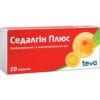
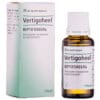

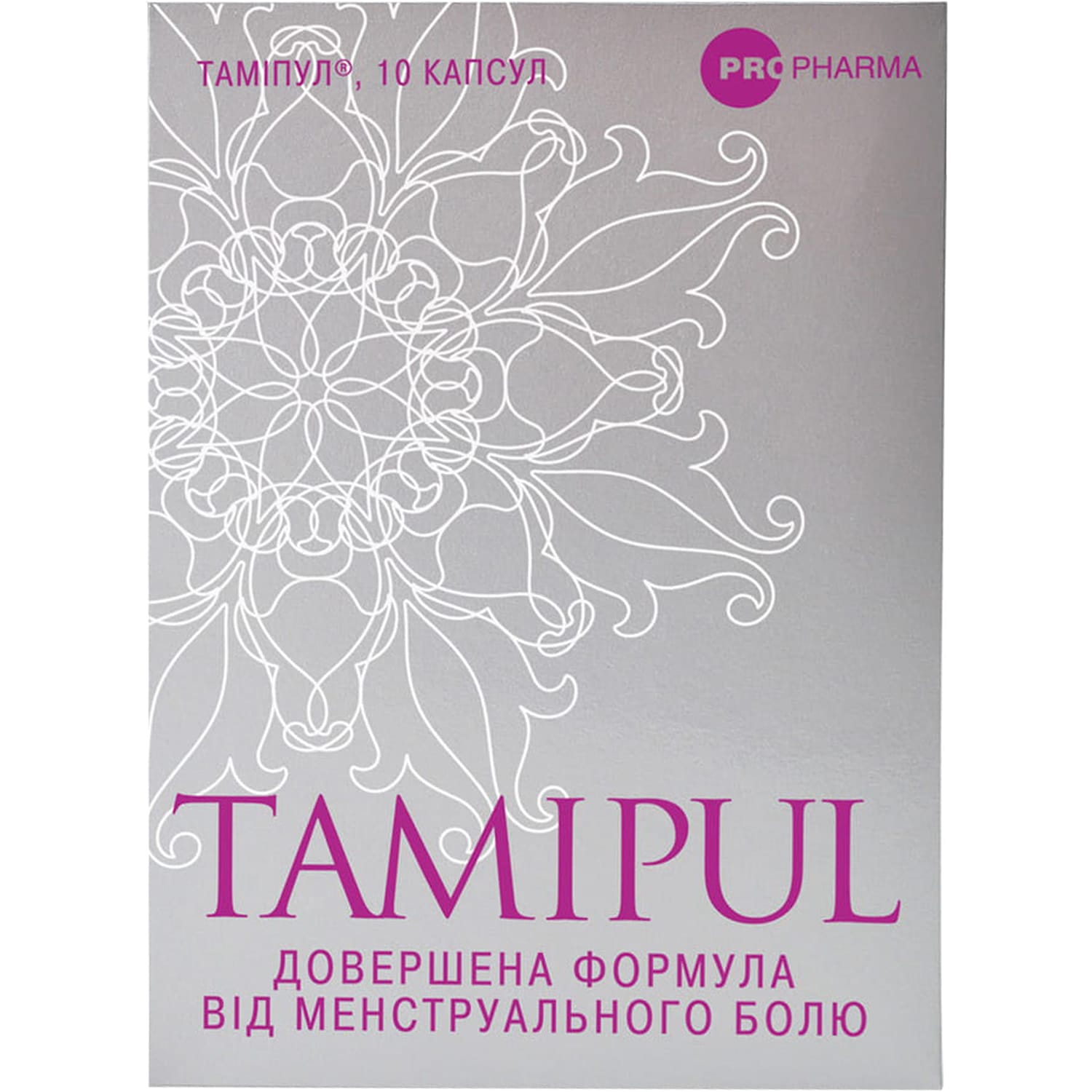


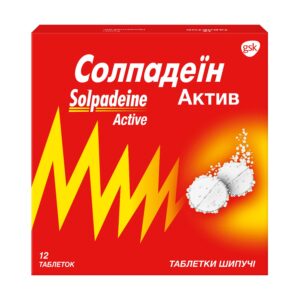
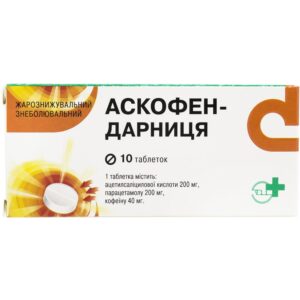
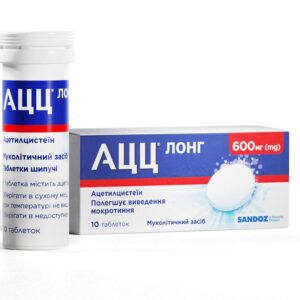
Reviews
There are no reviews yet.